NCERT Solution - Resource Mobilization, Entrepreneurship-3 | Entrepreneurship Class 11 - Commerce PDF Download
Application Based Exercise
Question. (i) Shraddha wants to start an Agro-based unit in Solan. What is she required to do to acquire a competent workforce for her proposed plant?
(ii) Suruchi is planning to establish a small scale export factory. To ensure that she is neither short of or in excess of capital, guide her how to go about for financial resources.
(iii) Mr. Nair, while planning for the financial requirement, overlooked the use of Technology in Production. What loss can befall on society because of his act of ignorance.
(iv) Mukesh is planning to establish a restaurant at Connaught Place, Delhi. What patterns of capital structure are available to him? Give reasons.
(v) Shalini plans to set up a Printing Press in Ludhiana. She looks upto her cousin Amit, who is successfully running a similar unit in Jaipur, for all possible help, guidance and suggestions. What kind of mentoring is this?
(vi) Malti, wants to commence a Blue Pottery Enterprise. Before starting, multiple information is required as a part of her systematic planning. Discuss the methods available to her to collect the required data.
Answer: (i) People required for various positions throughout the enterprise gets affected by:
(a) Finding out the total amount of works to be done and then dividing it into different sets of activities.
(b) The total number of tasks and jobs required to be accomplished under different activities.
(c) How much work can the average person do in a specified period of time?
(d) Level of absenteeism expected.
(e) Level of labour turnover.
(f) The present number of employees.
(g) The future plans for expansions, diversification and growth.
(ii) It refers to a small scale industry unit can be known as export-oriented unit if it exports more than 50% of its production. Such type of units have the benefit like subsidy offered by the government.
The Ministry of MSME & ARI will bring out a specific list of hi-tech and export oriented industries which would require the investment limit to be raised upto Rs. 5 crores to admit of suitable technology up gradation and to enable them to maintain their competitive edge. These method will ensure that she is neither short of or in excess of capital, guide her how to go about for financial resources.
(iii) The capital requirement of a business enterprise can broadly be classified into two main categories. They are:
(i) Fixed capital requirements (ii) Working capital requirements.
In general the technology to be used in production can be of two types
1. Capital-intensive Technique: It refers to more amount of capital required to start a business like machineries.
2. The labour-intensive technique refers to more number of labour to start the business. While planning for the financial planning technology in production to be used is one of the important decision taken by an entrepreneur and the financial requirements depends on a number of factors, the most important being the size of the enterprise, the industry group in which it operates and the nature of the technology employed. In general, small enterprises tend to have lower relative requirements for fixed as against working capital because of the high degree of labour intensity and if it a large scale industries the fixed capital requirement. Requirement is more as compared to working capital requirement as more investment in fixed assets. The fixed capital requirement should be correctly assessed and financed carefully for the smooth running of enterprise.
(iv) Capital structure is the composition or mix of different types of long-term capital whether owned or borrowed. It includes all the long term funds consisting of share capital, debentures, bonds, loans and reserves.
The patterns of financing, i.e. deciding about the types of securities to be issued for raising the necessary funds is what capital structure determines.
Patterns of capital structure are available to him.
In case of a new company, the capital structure may be of any of the following patterns: ( v ) It is a type of informal mentoring—Peer mentoring.Informal mentoring is a voluntary relationship. In this the satisfaction and personal rewards a mentor gains from an effective mentoring relationship. They are free to withdraw from it if it becomes unproductive or onerous. The mentored individual can, therefore, enjoy the advantages of the mentor relationship without guilt. The starting point is to be very clear on how a mentor could help you at this point in your career. What specifically do you need? This will be personal to your circumstances but might include one or more of the following:As he assist in her for preparation of documentation and other help• Personal-a mentor provides both professional and personal support
( v ) It is a type of informal mentoring—Peer mentoring.Informal mentoring is a voluntary relationship. In this the satisfaction and personal rewards a mentor gains from an effective mentoring relationship. They are free to withdraw from it if it becomes unproductive or onerous. The mentored individual can, therefore, enjoy the advantages of the mentor relationship without guilt. The starting point is to be very clear on how a mentor could help you at this point in your career. What specifically do you need? This will be personal to your circumstances but might include one or more of the following:As he assist in her for preparation of documentation and other help• Personal-a mentor provides both professional and personal support
• Career direction/guidance
• How to handle office politics?
• Options for skills development
• Professional/technical help
• Support through a decision-making process
• Organisational information/knowledge
• Help a mentee to assess his/her areas of shortcomings and strengths, giving critical feedback to him in key areas
• Helps in identification, procurement and utilization of resources required for the proposed venture
• Provides consultation, and helps in coordinating activities aimed at accessing funds, new technologies, etc.
(vi) Methods of Collection:
The different methods of collecting data are as follows:
(а) Direct Personal Investigation: It refers to the method by which the investigator collects the information personally from the informants and the source concerned. It can be possible if field of investigation is limited. More degree of originality and accuracy is required.
(b) Indirect Oral Investigation: The investigator collects the information not from the original person but approaches certain sources which are close or to be known directly or indirectly to the informants.
• It can be more suitable, if the field of investigation is large.
• There is no possibility of direct contact.
• The concerned informants are not able to read and write.
• Mostly used in government departments.
(c) Local Correspondents: The investigator appoints local agents or correspondents in different parts of the area under investigation. Generally, they collect the information according to their skills and tactfulness and then submit it to the investigators.
• It is more suitable when regular and time to time information is required.
• Area has wide coverage.
• The availability of information is possible through magazine, journals, annual
report.
(d) Mailed Questionnaire: It refers to the type prepared by the investigator keeping in view the objective of the inquiry and sends it to informants/respondents who post or e-mail. The informants fill it completely by himself and send it back to the investigator.
(e) Questionnaire through enumerators: The enumerators go to informants along with the questionnaire to help fill the questionnaire according to the answers given by the informants. It is also known as schedules.
MORE QUESTIONS SOLVED
I. Very Short Answer Type Questions [1 Mark]
Question 1. Name the word ‘mentor’ comes from.
Answer: The word mentor comes from the character “Mentor” in Homer’s epic tale, The Odyssey.
Question 2. What do you understand by mentorship?
Answer: Mentorship is a developmental partnership through which one person shares knowledge, skills, information and perspective to foster the personal and professional growth of someone else.
Question 3. Why mentor is also called as trusted guide?
Answer: Mentor is also called as trusted guide because he is a wise advisor, creates an informal environment, in which the other person feels encouraged to discuss their needs and circumstances openly and with confidence.
Question 4. What do you understand by captive unit arrangements?
Answer: Captive Service is a portion of Business Process Outsourcing where an organization will use a wholly owned subsidiary instead of a Third Party Vendor. Parent company will use the resources made by the subsidiary company , with the only benefit of reducing the cost of production, cost of saving of using outside resources and easily maintaining and complete control over the process.
Question 5. What do you mean business etymology of “business”?
Answer: The etymology of “business” relates to the state of being busy either as an in dividual or society as a whole doing commercially viable and profitable work.
Question 6. How L.H. Haney has defined the term ‘ Business’?
Answer: “Business may be defined as a human activity directed towards producing or acquiring wealth through buying and selling of goods”. L.H. Haney
Question 7. Define strategy.
Answer: ’’Strategy is the direction and scope of an organisation over the long-term; which achieves advantage for the organisation through its configuration of resources within a challenging environment, to meet the needs of markets and to fulfil stakeholder expectations”. —Johnson and Scholes
Question 8. How will an entrepreneur can classify business activities?
Answer: Business activities can be also classified on the following grounds/basis:
(i) activity (ii) size (iii) ownership.
Question 9. Neerja wants to start a small size business in her colony. Give some examples of tiny units she can approach for.
Answer: Stationery shop, schools, parlours, photostate and STD booths in your locality.
Question 10. Who is called as a brain box of the enterprise?
Answer: Managerial staff is called as a brain box of the enterprise.
Question 11. Why some entrepreneurs outsource professional experts?
Answer: Professional experts can be outsourced by the entrepreneur because the small enterprises cannot afford them on their regular payrolls.
Question 12. Give examples of professional experts who render their services to run the business enterprises.
Answer: Chartered accountants, auditors, bankers, lawyers, are important professional experts who render their services to run the business enterprises.
Question 13. What features are to be considered for adopting the technology by an enterprise?
Answer: The technology should he latest, valid, credible, and must have proper and have sound technical values.
Question 14. What do you mean by the term licentiates?
Answer: Licentiates refers to any individuals holding professionals licenses, or it indicates that any person who holds a certificate of competence to practice a profession. They may run to partnership, firms, or corporations as well as to individuals.
Question 15. If an entrepreneur cannot personally supply the necessary amount of money he can go for another option, i.e. (OPM) .What does this OPM stands for?
Answer: OPM stands for ‘OTHER PEOPLE’S MONET.
Question 16. How an entrepreneur workout financial resourcing for a business?
Answer: (1) How much finance is required?
(2) The terms for which finance is required.
(3) What are the sources of generating finance?
Question 17. What constitutes borrowed capital?
Answer: The capital, which is borrowed by the entrepreneur from banks, financial organizations, or from any other source constitutes borrowed capital.
Question 18. What do you understand by intangible resources?
Answer: These resources are neither be touched or can be seen but that have value but helps immensely in providing a strong foothold to enterprise.
The intangible possession is a resource which enables a business to continue to earn a profit that is in excess of the normal basic rate of profit earned by other business of similar type.
Question 19. Enumerate the categories of intangible resources.
Answer: This category generally comprises:
(i) Goodwill (ii) Reputation
(iii) Brands (iv) Intellectual Property.
Question 20. What do you mean by goodwill?
Answer: Goodwill = acquisition price – net assets.
Question 21. What do you mean by reputation?
Answer: It is business tactics which could help gather the necessary support from employees and suppliers to get good name in the market.
Question 22. What do you mean by Intellectual Property?
Answer: The steps in the process of financial planning are as follows:
Question 23. Define financial planning.
Answer: Financial planning is deciding in advance how much to spend, on what to spend on the basis of availability of funds.
Question 24. How strong brands help an entrepreneur as a key factor?
Answer: Strong brands are often the key factors to know in whether a growth strategy is a success or failure and it will help an entrepreneur to command and sustain with higher margin.
Question 25. Define financial planning.
Answer: Financial planning is deciding in advance how much to spend, on what to spend on the basis of availability of funds.
Question 26. What do you understand by manning table?
Answer: A manning table is a listing of the positions or number of workers to be used in the operation of a particular machine or process.
Question 27. What is the basis of obtaining unsecured loans?
Answer: Unsecured loans are mostly given on the credit worthiness and capacity to pay of an entrepreneur.
Question 28. Why is finance called as a master key?
Answer: Finance is also known as the master key because it provides access to all the other sources for being employed in manufacturing, trading and services activities.
Question 29. What do you mean by the manning table?
Answer: It refers to a listing of the position of workers number of employees to be used from top level to lower level in the manufacturing process or of a particular machine or for a particular job.
Question 30. Define the term ‘Job’.
Answer: ‘Job’ is a task or piece of work especially one that is paid.
II. Short Answer Type Questions [2/3 Marks]
Question 1. What are the steps in the process of financial planning?
Answer: The steps in the process of financial planning are as follows:
(a) Estimation: Amount of funds or capital to be required in the future is estimated.
Here, the amount of money to be raised bases on goals is determined.
(b) Determining securities: For acquiring capital what securities are to be issued is determined here. The form, types, size, etc. of the securities is to be fund to be raised,
(c) Formulation of policies: After estimating the requirement and determining securities, the next is formulating policies for administrating the capital. This involves the making of various targets, ensuring proper utilization of funds, etc.
Question 2. Define Finance.
Answer: Finance may be defined as the provision of money at the time as per the requirement.
Question 3. How an entrepreneur sources to procure finance for small business?
Answer: Finance is required whether the business is small or large. Sources of procurement of finance for small business : Own saving or raise loans from relatives, friends or some financial institutions.
Question 4. Define Business Finance.
Answer: Business Finance may be defined as the acquisition and utilization of capital funds in meeting the financial needs and overall objectives of a business enterprise.
Question 5. “Business Finance is an activity”. Comment.
Answer: Business finance is that activity because it is concerned with the planning, fund raising, controlling and administering and managing of all the funds to be used in the business enterprises whether business is small or large.
Enumerate two major of financial decision-making by an entrepreneur.
The two major areas of financial decision-making, requires on part of entrepreneur to take the:
(a) Funds requirement decision: It is concerned with the estimation of total funds required to start and run the business enterprise.
(b) Financing decisions: It is concerned with the sources from which the funds are to be raised.
Question 6. Difference between seed capital and margin money.
Answer:
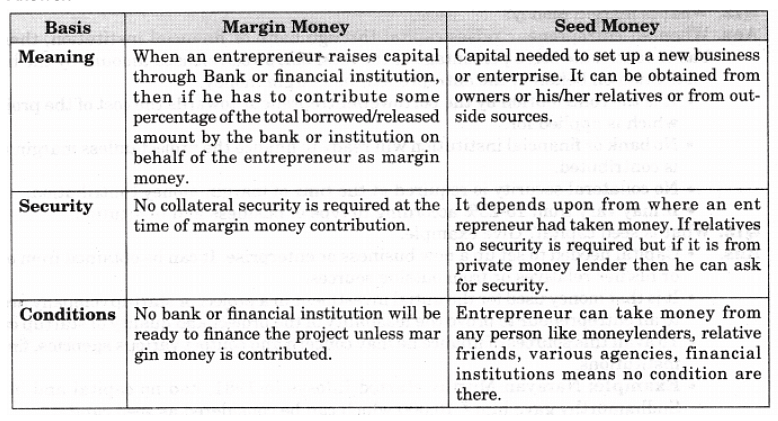
Question 7. What do you mean by over-capitalisation?
Answer: Overcapitalisation signifies a situation when an enterprise possesses excess of assets in relation to its actual requirements.
Overcapitalization always indicates that actual earning is always lesser than the decided one.
Question 8. What do you mean by under-capitalisation?
Answer: It refers to a situation when actual capitalisation is lower than the proper capitalisation. Under-capitalisation capital always shows the assets value may be more than the values reflected in the books of accounts.
Question 9. How need of financial resources helps an entrepreneur?
Answer:
- Finance is one of the important prerequisites to start an enterprise.
- It helps an entrepreneur to arrange all other required resources together like, personnel, machines, materials, methods, land, etc. to startup the business systematically.
- It helps an entrepreneur to start his business activities smoothly and convert a dream into reality.
Question 10. What do you understand by owner’s funds? Enumerate the forms of owner’s funds.
Answer: Owners fund is a type of finance for an enterprise. It is that part of total investment that belongs entirely to the entrepreneur of the business.
- This fund can be provided by a single owner or by a group of owners.
- In such funds the risk is to bared by the owner himself.
- More is the proportion of owner’s fund in the enterprise, higher control is enjoyed by the entrepreneur.
Owner’s funds can be in the form of:
(a) Equity capital (b) Preference capital (c) Margin money/Seed money
Question 11. What is short term capital?
Answer:
- The amount of capital which is invested in the enterprise for a period less than one year.
- Such capital is needed for fulfilling the day to day requirements of the enterprise. It is needed for procuring raw material, finished goods, spare parts, advertising, marketing etc.
- Such capital is obtained from financial institutions against the securities. It is needed more by the enterprises having longer length of operating cycle.
Question 12. What is margin money?
Answer: When an entrepreneur raises capital through bank or financial institution, then if he has to contribute some percentage of the total borrowed/released amount by the bank or institution on behalf of the entrepreneur as margin money.
- It is the contribution by the borrower/entrepreneur towards the cost of the project for „ which is applied for.
- No bank or financial institution will ready to finance the project unless margin money is contributed.
- No collateral security is required at the time of margin money contribution.
- It may vary from 15-25% according to type of business and institution.
Question 13. What is seed capital? Give example.
Answer:
- Capital needed to set up a new business or enterprise. It can be obtained from owners or his/her relatives or from outside sources.
- It is that money used for the initial investment in a project or startup company provided to an entrepreneur to prove the feasibility of the project and quality of startup capital.
- To avail this sources of finance he may concern and contact various agencies, financial institutions.
- Example: Narayan Murthy started Infosys in 1981, had no capital and his wife Sudhamurthy gave him Rs 10,000 which can be considered as seed capital.
Question 14. State any three important aspects which is mandatory for an entrepreneur regarding the proper planning and disbursement of funds:
Answer:
- The total amount of finance required for implementing the business plans (how much money is needed)?
- The forms and proportion of various securities to be used for collecting the desired amount, such as, where the money will come from.
- The policies of utilization and administration of capital, (how can the firm utilize these funds in the best possible manner)?
Question 15. What do you understand by finance?
Answer: The entrepreneur at every point of time needs money and he makes the arrangement of money whenever it is needed.
More is the size of enterprise more is the requirement of finance and it is used for purchasing raw materials, tools, equipments, hiring services, etc. thus we can say- finance means the arrangement of money at the time it is required is finance.
Question 16. “Sound financial planning is necessary for the success of any business enterprise”. Explain
Answer: Yes, I agree with the statement. It entails.policies and procedures for proper coordination between the various functional areas of business, involving proper allocation of resources amongst the various departments.
Question 17. How a business enterprise gets affected without an accurate financial plan?
Answer: Any enterprise/entrepreneur will start his business with an accurate plan embodying the financial needs of the company in the present and future. It is definite that the enterprise may have to face frequent difficulties and obstacles which may hamper the growth of an enterprise.
Question 18. What does a mentor do?
Answer: As a teacher he teaches the mentee about a specific issue.
As a coach coaches the mentee on a particular skill.
As a facilator he facilitates the mentee growth by sharing resources and networks.
As a challenger he challenges the mentee to move beyond his or her comfort zone.
And he always creates a safe learning environment for taking risks and focuses on the mentees total development.
Question 19. What do you understand by ‘Silo Mentality’?
Answer: It is a situation in some organisation/business firms where few people work in a different mindset. In these the employees in the same organisation or departments employees do not wish to share information/knowledge with other individuals or other departments. It is also called as a attitude problem of an enterprise.
Question 20. What do you understand by the term business?
Answer: An economic activity which is conducted on regular basis to earn profit through the sale, exchange or transfer of goods and services, is referred as business.

Question 21. How can mentoring be classified on two grounds?
Answer: Mentoring thus may be classified on two grounds:
(a) Mode of construction (in which way mentorship is structured)
(b) Mode of delivering (in which manner mentorship is rendered)
Question 22. How to overcome ‘Silo Mentality’ in an organisation?
Answer:
- Giving new employees good atmosphere, and proper orientation and make them to understanding of all departments, encourage them to work in team.
- Regularly good communication and check with all the activities in the organisation and briefing the employees.
- Time to time taking good decision and careful regarding the selection and proper training of employees.
All these techniques will help an organisation and team leader to achieve the organisational goals and objectives.
Question 23. Different firms need different resources. Enumerate the requirement of resources depends upon.
Answer: Different firms need different resources. The requirement of resources depends upon:
(a) Nature of activity (b) Size of activity
(c) Product specification (d) Type of business activity.
III. Short Answer Type Questions [4 Marks]
Question 1. What are the features of borrowed capital?
Answer: Borrowed capital is the capital borrowed by the enterprise for the normal running of the enterprise. Its features are:
- Interest: The borrowed capital has to be repaid with interest.
- Time period: The borrowed capital is to be paid back in the agreed time limit. Thus, it is the obligation of the entrepreneur.
- Right of control: The lenders of borrowed capital normally have no control over the management of the enterprise. However, some conditions are to be fulfilled by the entrepreneur.
Question 2. Mention the various sources of raising short term capital.
Answer: Trade credit, cash credit, bank overdraft, discounting bill of exchange, etc. some sources of raising short term capital.
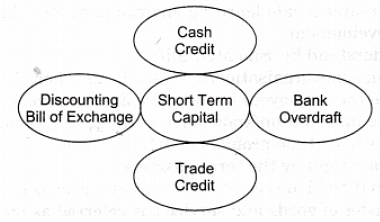
Question 3. What is medium term capital?
Answer: The amount of capital which is invested by the entrepreneur from a period more than one year but less than five years is medium-term capital. Such capital can be raised through debentures; loans from financial institutions, preference shares, etc. and it can be used for development, extension, expansion, and modernization, etc. of the enterprise. It may or may not form a part of working capital. Normally it is not used as working capital.
Question 4. What is meant by long term capital? Why is it needed?
Answer: The amount of capital which is invested in the enterprise for a period more than five years but less than 25 years is a long term capital. It is needed for the following:
(a) For acquiring fixed assets like building, machines, etc.
(b) For development of enterprise.
(c) For research related with product.
Question 5. What is collateral security?
Answer: It refers to a security of fixed assets given by an entrepreneur to banks and financial institutions against a sum borrowed by him. The assets mortgaged with the institution for the sanction of a loan. Except certain government schemes, banks and financial institutions require physical (asset) security to release loans. Fixed assets like buildings, land, machinery, etc. Registered in the name of entrepreneur can be used as security to release loans.
Question 6. How the ‘Silo Mentality’ in workplace affect the enterprises culture?
Answer: A silo mentality is an attitude found in some organisations that occurs when several departments or groups do not want to share information or knowledge with other individuals in the same company.
Increasing effect of Silo Mentality always :
- Reduces efficiency of overall business enterprise.
- It leads to poor communication, reduced trust, and often keeps one department or group against another.
- This leads to cost overruns, project delays, wasted efforts, poor products falling production and falling sales and ultimately less profit.
- It gives a bad reputation of an organisation in the market.
- It reduces morale among the employees.
Question 7. What happen if an entrepreneur run his enterprise with outdated, obsolete, worn-out machinery or stick into sick plants?
Answer: If an entrepreneur runs his enterprise with outdated, obsolete, worn-out machinery or stick into sick units then it will result in bad capital budgeting decisions but also hamper the innovation and creativity of an entrepreneur.
Question 8. What are the abilities a successful entrepreneur should possess?
Answer: The success of any enterprise lies in the capacity and ability of the entrepreneur to:
(i) Mobilize the resources
(ii) Organize the resources
(iii) Manage them efficiently and effectively as they are always scarce with reference to their demand.
Question 9. What three important decisions are to be taken by an entrepreneur for efficient utilization of human resources?
Answer: Thus efficient utilization of human resources is only possible if the entrepreneur is able to decide:
(i) The total work to be done
(ii) The right type of people who can do the work.
(iii) Employing right man at right job.
Question 10. Why an entrepreneur realized that there is a need of Expert Professional Assistance to an enterprise for more efficiencies in their operation and can easily reduce the cost in effectiveness?
Answer:
- Need of expert Professional Assistance in an enterprise for more efficiency in their day-to-day activities and can easily improve the cost effectiveness.
- Entrepreneur realizes that he can’t be an expert in all the areas and cannot do proper justice in all the areas of an enterprise.
- Individually no entrepreneur can utilize properly all resources, time and energy to meet their day-to-day requirements of the enterprise.
Thus, either outsourcing or availing of professional services from outside the firm, has become a major trend in human resources over the past decade.
Question 11. Enumerate the various methods by which an entrepreneur can arrange various types of resources.
Answer: It is for the entrepreneur to analyse and evaluate the extent, nature and type of resource required. Commonly, one can arrange for these through:
- Contractual arrangements
- Third party arrangements
- Lease basis
- Captive unit arrangement
- Part time arrangement
- Regular basis.
Question 12. What is the difference between Term Loan and Demand Loan?
Answer: Difference Between term loan and demand loans.
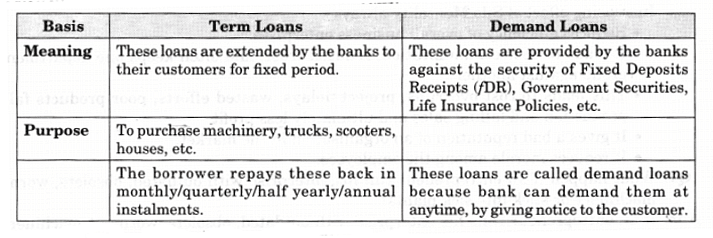
Question 13. What do you understand by intangible resources?
Answer: An intangible asset is an asset that does not physically or materially exist: Though an individual may not be able to view or touch an intangible asset, it can still be extremely valuable. In most cases, it is the companies that possess intangible assets, such as business contracts.
Question 14. Distinguish between Formal mentoring and Informal mentoring.
Answer:
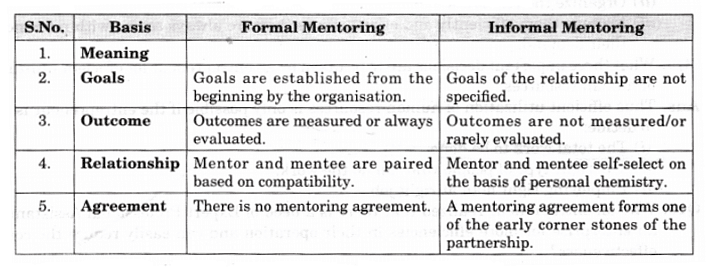
Question 15. “A mentorship relationship is based on trust.” Do you agree? Comment. Answer: Yes, I agree with the statement. The relationship between mentor and mentee is totally based on trust.
Answer: Yes, I agree with the statement. The relationship between mentor and mentee is totally based on trust.
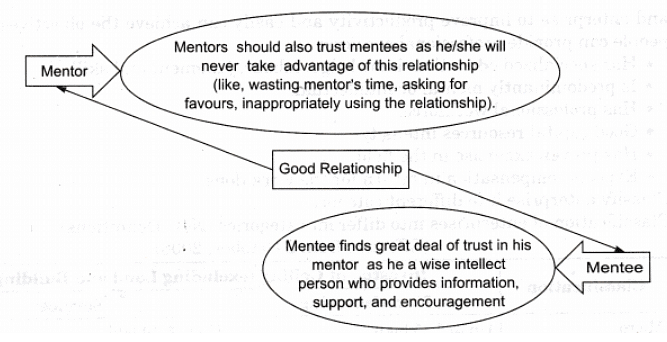 Building trust can take time; our behaviours can accelerate the time it takes.
Building trust can take time; our behaviours can accelerate the time it takes.
Question 16. Draw a flow chart of types of mentoring.
Answer:
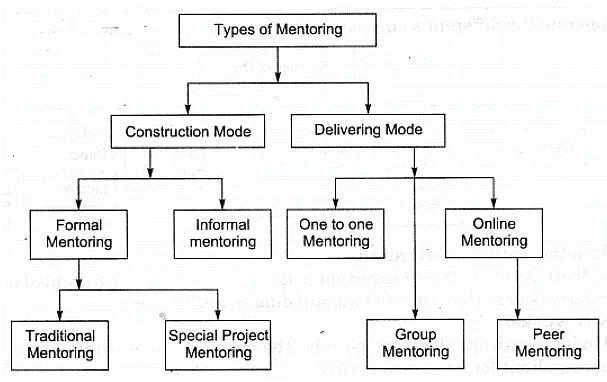
Question 17. Explain the features/characteristics of the term business.
Answer: Characteristics of the term business are the following:
(a) It is a day-to-day economic activity of the enterprise.
(b) It deals with exchange, sale, transfer of goods and/or services in the enterprises with
various types of people. .
(c) Exchange of goods, sale or transfer of goods and services can be cash basis or it can be credit basis.
(d) There is regularity in dealings means daily, weekly, monthly, quarterly, six monthly etc.
(e) The main motive of every business dealings are with profit motive.
(f) Every business has an element of risk.
(g) Business deals with creation of utility.
(h) To be business the activity should be capable of consumer satisfaction.
Question 18. What are professional services?
Answer: Professional services support entrepreneurs and enterprises of all types whether small scale industries or large scale industries in the economy. The provided services includes . legal advice, tax advice, financial advice and business advice. It helps an entrepreneur and enterprise to improve productivity and easily can achieve the objectives. All those
people can provide professional services:
• Has specialized education, knowledge, labour, judgment and skill.
• Is predominantly mental or intellectual.
• Has professional workforce.
• Good capital resources intensity.
• Has proven expertise in the field.
• Expects compensation in return for the work done.
Question 19. Classify enterprise into different categories.
Answer: Classification of enterprises into different categories (New Definitions)

Question 20. Enumerate the different sources of debt.
Answer:

Question 21. Explain the features of overdraft.
Answer: Overdraft: A temporary arrangement in the form of a permission granted to the customers to withdraw more than the amount standing to his/her credit.
How it works:
(i) Under overdraft, the bank permits the customer to overdraw his account up to a
certain limit for an agreed period. .
(ii) To avail of this facility, a customer should have a current account with that bank.
(iii) Interest is charged on the amount actually overdrawn.
(iv) Overdraft may be allowed on the security of assets or customer’s personal security.
Question 22. What do you mean by business cycle? Draw diagram.
Answer: The term business cycle refers to economy-wide fluctuations in production, trade and economic activity in general over several months or years in an economy organized on free-enterprise.
Principles: It is also known as economic cycle or boom-bust cycle.
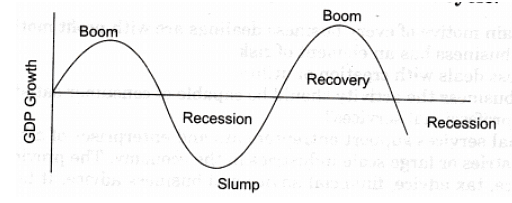
Question 23. Name:
(а) The activities connected with the production are called as.
(b) The activities connected with the distribution of goods produced from the factories to the consumers are called.
(c) Name the better way of classifying business activities.
(d) Industrial unit whose investment in plant and machinery does not exceed ? 5 crores.
(e) During inflation, an entrepreneur need more working capital or less working capital.
(f) Name the type of credit in which credit period of 180 days is extended on purchase of
supplies.
Answer: (a) Industry
(b) Commerce.
(c) A better way of classifying business is size-wise.
(d) Small scale industries.
(e) More working capital.
(f) Trade credit.
Question 24. Categorise the types of Small Scale Industrial Unit with their investment capacity and limits.
Answer:
 Question 25.Differentiate between cottage industries and rural industries
Question 25.Differentiate between cottage industries and rural industries
Answer:

Question 26.Distinguish between shares and debentures.
Answer:

Question 27.What do you understand by physical resources? Availability of resources determines the location of an enterprise. Do you agree? Justify of your answer?
Answer: Yes, it is true that availability of resources determine the location of an enterprise. It is because of following reasons:
(a) Cost factors: If sources of resources are near the enterprise then the transportation cost is reduced.
(b) Supply factors: The supply of resources is quick if resources are readily available.
(c) Maintenance: The maintenance of machinery becomes easy as vendors are readily available.
IV. Long Answer Type Questions [6 Marks]
Question 1. What are the advantages and limitations of owner’s funds?
Answer: Advantages of owner’s funds
(a) Control: More is the owner’s fund in the enterprise, higher is the control of the owner. Thus, it increases the control of entrepreneur.
(b) Risk: More is the owner’s fund, more is the limit of risk. This is because such funds do not increase the obligations of the enterprise.
(c) Decreases Obligations: Higher is the owner’s funds in the over all capital of the enterprise, lesser is the obligations of the entrepreneur.
(d) Encourages Development: Such funds if used for purchasing fixed assets leads to the development of the enterprise.
Limitations of Owner’s Fund
(a) Fixed: Owner’s funds are fixed. It cannot be raised immediately. Its accumulation also needs time.
(b) Depends on savings of the owners: Savings of the owners depends on the income of the owner. Income in turn depends on the profitability of the owners fund is also low.
Question 2. Enumerate the advantages and limitations of borrowed capital.
Answer: Advantages of borrowed capital:
(a) Tax deductible: The interest paid on the borrowed fund is tax deductible, i.e. no tax is to be paid by the entrepreneur on interest.
(b) Convenient: The capital can be borrowed whenever needed by the enterprises. Many financial organisations are always ready to provide it. However, the amount lend by such organisations depend on the paying capacity of the enterprise.
(c) No dilution of control: Normally the financial organisations do not interfere in the matter of the enterprise. The entrepreneur is free to work even after borrowing.
(d) Reputation can be encased: Higher is the reputation of the enterprise in the society; higher are the chances of obtaining capital easily. Thus, the brand name of the enterprise can be utilized.
Limitations of borrowed capital:
(a) Fixed period: This capital is obtained for an agreed period of time. Also the interest and the principal amount are to be paid back in a given period of time.
(b) Increases obligations: The borrowed capital increases the obligation of the enterprise as the interest is to be paid periodically.
(c) Depends on security: Borrowed capital is obtained against security. Such securities if not available, then the enterprise is devoid of obtaining this capital.
Question 3. Enumerate the sources of long term capital.
Answer: Long term capital can be obtained through equity share, preference shares, debentures, as’loans from financial institutions, owner’s capital, undistributed profit of the enterprise, etc.
A form of secondary protection sometimes required by a bank and intended to guarantee a borrower’s performance on a debt obligation. The primary security on a substantial business loan is typically the thing that is being financed, such as a factory, company car or shipment, but secondary or collateral security might also be requested by a bank to help assure that the loan will be repaid.
Question 4. What is the difference between a secured and unsecured loan?
Answer:

Question 5. How reducing silo mentality in workplace is always beneficial to a business firm?
Answer: It is a mindset of a group of people working in an organisation who do not wish to communicate and share their knowledge and information to other departments and colleagues.
Reducing silo mentality in workplace is always beneficial to a business firm as :
- It increases efficiency of overall business enterprise.
- It leads to good communication, increasing trust, and often keeps one department or group collaborated to each other.
- This leads to cost effectiveness, completion of project on time, full utilization of all resources and reduce wastage.
- Production of quality product, highest annual turnover and high profit., poor products falling production and falling sales and ultimately less profit.
- It gives a good reputation of an organisation in the market.
- It shows synergy of team in the organisation.
Question 6. How an entrepreneur decides about the quantity of personnel the enterprise needs?
Answer: The number of personnel required for various positions throughout the enterprise gets affected by following points :
(a) Finding out the total amount of works to be done and then dividing it into different sets of activities.
(b) The total number of tasks and jobs required to be accomplished under different activities.
(c) How much work can the average person do in a specified period of time?
(d) Level of absenteeism expected.
(e) Level of labour turnover.
(f) The present number of employees.
(g) The future plans for expansions, diversification and growth.
Question 7. How availing professional expertise assist and help an entrepreneur to access better cost efficiency?
Answer: Availing professional expertise assist and help an entrepreneur to access better cost efficiency on regular basis are as follows :
(a) Wastage can be reduced.
(b) Savings of time, cost and energy.
(c) Higher efficiency and effectiveness in all the area because of professional expertise are in the concerned and specialised in that particular field.
(d) Focus on the core areas/activities of the enterprise.
(e) Avail of qualified quality service in time bound frame and at fraction of cost.
(f) Lower the chances of risks.
(g) Save on additional fixed investment required in the creating infrastructure for ‘providing these facilities on one’s own.
(h) Enhance business due to others expertise and experience in the defined field.
(i) Access to new and growing markets.
Question 8. How will an entrepreneur classify the human resources required by an enterprise?Explain with the help of manning table.
Answer: Efficient Utilization of Human Resource:
1. Managerial Staff:
- They are generally work like brain box of an enterprise.
- They frame out policies, programmes, mission, vision objectives goals of an enterprise.
- They ensure their implementation and finally getting the work done from workers
is the field area of this category.
2. Non-managerial Staff:
- They are the real group of workers can be called as a backbone according to their skills and experience.
- They effectively converts the raw material into finished goods.
- Their nature of job, skills and experience decides the quality and quantity of workers to be assigned.
3. Trained Technical Manpower:
- They are technical experts.
- The main job assigned to them are:
- Selection of machinery, get training if required to operate the purchased machinery.
- Installation of machinery and maintenance of machinery.
- Continuous supervision and operation.
4. Administrative Manpower:
- These are the group of staff who provide support services to managerial, professional and trained staff to run the enterprise effectively the maintenance of the enterprise.
- They play an important role and connect all the staff members by providing and assisting services to them.
- They do not contribute to production directly but only provide assisting services.
5. Professional Manpower: Chartered accountants, auditors, bankers, lawyers, who are professional experts and they can be outsourced by the entrepreneur if required. Small enterprises cannot afford them on their regular payrolls.
Thus, efficient utilization of human resources is only possible if the entrepreneur is able to decide:
- The total work to be done.
- The right type of people who can do the work.
- Employing right man at right job.
Question 9. State whether the following require small or large working capital. Answer should be supported by a valid reason:
Answer:
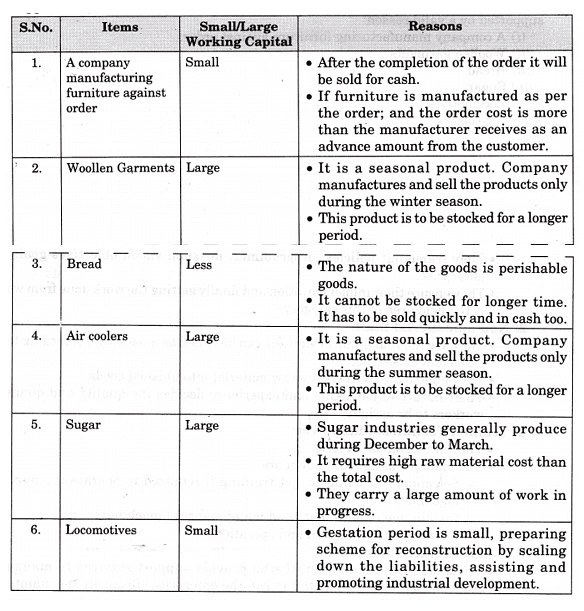
|
37 videos|52 docs|15 tests
|
















